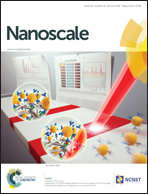Novel multi-functional europium-doped gadolinium oxide nanoparticle aerosols facilitate the study of deposition in the developing rat lung†
Abstract
Ambient ultrafine particulate matter (UPM), less than 100 nm in size, has been linked to the development and exacerbation of pulmonary diseases. Age differences in susceptibility to UPM may be due to a difference in delivered dose as well as age-dependent differences in lung biology and clearance. In this study, we developed and characterized aerosol exposures to novel metal oxide nanoparticles containing lanthanides to study particle deposition in the developing postnatal rat lung. Neonatal, juvenile and adult rats (1, 3 and 12 weeks old) were nose only exposed to 380 μg m−3 of ∼30 nm europium doped gadolinium oxide nanoparticles (Gd2O3:Eu3+) for 1 h. The deposited dose in the nose, extrapulmonary airways and lungs was determined using inductively-coupled plasma mass spectroscopy. The dose of deposited particles was significantly greater in the juvenile rats at 2.22 ng per g body weight compared to 1.47 ng per g and 0.097 ng per g for the adult and neonate rats, respectively. Toxicity was investigated in bronchoalveolar lavage fluid (BALF) by quantifying recovered cell types, and measuring lactate dehydrogenase activity and total protein. The toxicity data suggests that the lanthanide particles were not acutely toxic or inflammatory with no increase in neutrophils or lactate dehydrogenase activity at any age. Juvenile and adult rats had the same mass of deposited NPs per gram of lung tissue, while neonatal rats had significantly less NPs deposited per gram of lung tissue. The current study demonstrates the utility of novel lanthanide-based nanoparticles to study inhaled particle deposition in vivo and has important implications for nanoparticles delivery to the developing lung either as therapies or as a portion of particulate matter air pollution.


 Please wait while we load your content...
Please wait while we load your content...